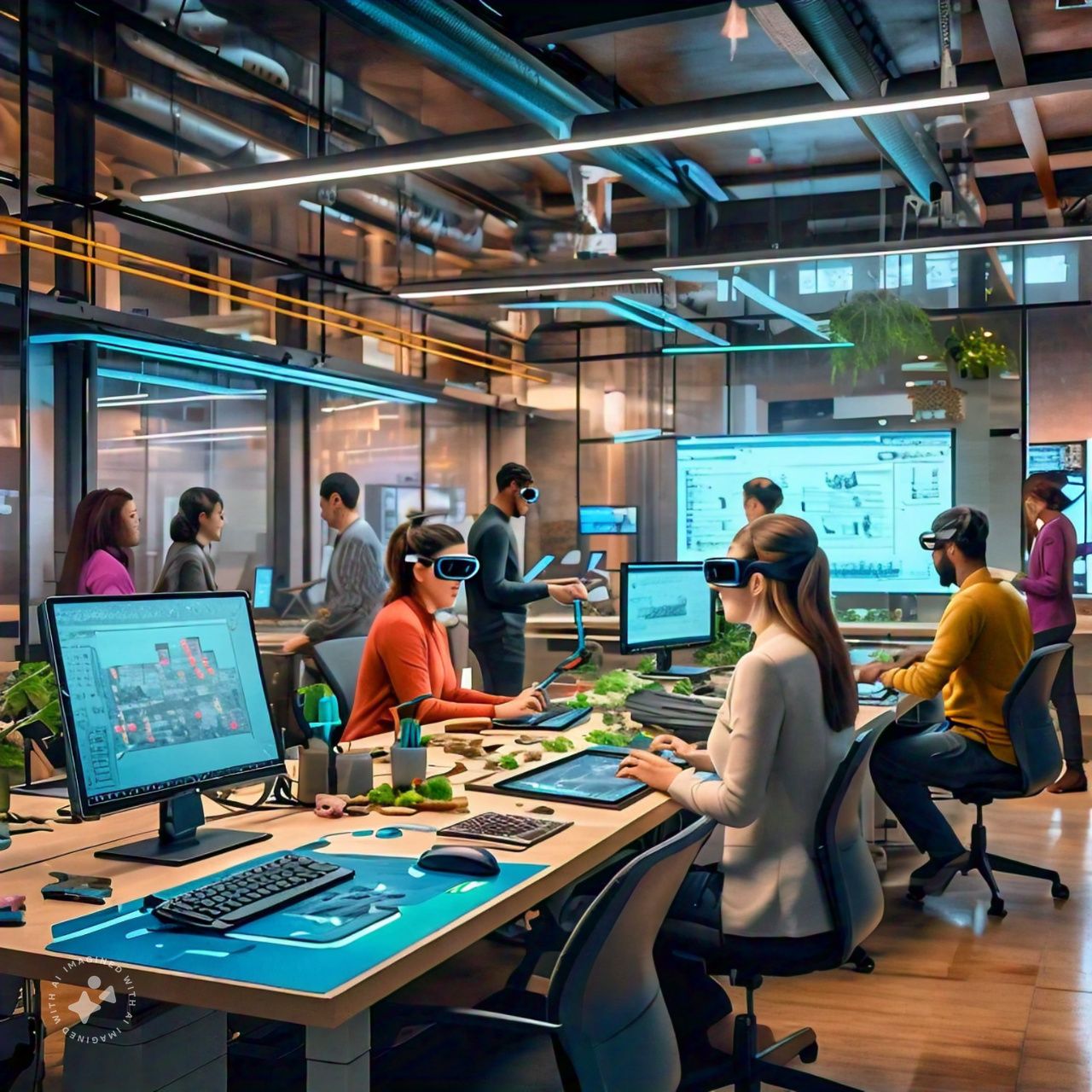The Future of Work: How Technology is Shaping the Workforce
The workforce is undergoing a seismic transformation, driven largely by advancements in technology. Automation, artificial intelligence (AI), remote work tools, and digital platforms are reshaping how, where, and why people work. As technology evolves at an unprecedented pace, the future of work is becoming more flexible, efficient, and interconnected, but it also raises significant challenges and questions about the future of jobs, skills, and the nature of work itself. This article explores the key technological trends shaping the workforce and how they will influence the workplace in the coming years.
1. The Rise of Remote and Hybrid Work Models
One of the most significant shifts in the workforce has been the widespread adoption of remote work. While the pandemic accelerated this trend, the use of digital collaboration tools, cloud computing, and virtual meeting platforms has made remote work feasible and effective for many industries. As a result, remote and hybrid work models are likely to become a permanent fixture of the future workplace.
Remote Work Technology
Advancements in cloud computing, video conferencing software like Zoom and Microsoft Teams, and project management tools such as Slack and Asana have made it possible for teams to collaborate seamlessly from any location. This flexibility allows employees to balance work and personal life better, reduces commute time, and opens up access to talent from around the world. According to a report from McKinsey, 58% of U.S. workers who can work remotely now do so, and many are expected to continue doing so in the future.
Hybrid Work Models
As companies return to physical office spaces, hybrid models, which combine in-person and remote work, are emerging as a popular solution. These models give employees the flexibility to work from home part-time while also engaging in face-to-face collaboration at the office. This flexibility can improve work-life balance and increase employee satisfaction, though companies must adapt to new challenges in terms of maintaining team cohesion, company culture, and productivity in a hybrid environment.
2. Automation and Artificial Intelligence (AI): Revolutionizing Tasks and Jobs
Automation and AI are at the forefront of technological innovation, and their impact on the workforce is undeniable. These technologies are automating repetitive and mundane tasks, enhancing decision-making, and even creating entirely new roles in sectors like healthcare, finance, and customer service.
Automation in the Workplace
Automation tools, from robotic process automation (RPA) to machine learning algorithms, are streamlining processes in industries such as manufacturing, logistics, and finance. For example, in manufacturing, robots can handle repetitive tasks like assembly or quality control, while in finance, AI-driven algorithms are being used for risk analysis, fraud detection, and customer service. By automating routine tasks, employees can focus on higher-level, more creative, and strategic responsibilities.
AI and Data Analysis
AI is also changing the way businesses approach data. Machine learning algorithms are analyzing vast amounts of data to provide insights, predict trends, and improve decision-making. In marketing, AI tools are being used for personalized customer outreach, in finance for predictive analytics, and in healthcare for diagnosing diseases from medical images. AI is transforming industries by making processes more efficient, and companies that leverage these technologies are gaining a competitive edge.
Job Displacement and Creation
While automation and AI can lead to job displacement, they also create new opportunities. For instance, roles in AI development, machine learning, data analysis, and robotics maintenance are expanding. Additionally, businesses are increasingly seeking employees who can work alongside AI systems, requiring a new set of skills that blend technical expertise with creativity, emotional intelligence, and strategic thinking. Workers will need to adapt by reskilling and upskilling in order to remain competitive in the job market.
3. The Gig Economy and the Rise of Digital Platforms
Technology has given rise to the gig economy, where individuals work as freelancers or independent contractors rather than full-time employees. Platforms like Uber, TaskRabbit, and Upwork allow people to find short-term work opportunities that offer flexibility and autonomy, but also come with unique challenges.
Flexibility and Autonomy
Gig work offers employees the freedom to choose their hours and locations, making it an attractive option for those who value work-life balance or seek multiple income streams. These platforms have enabled individuals to build flexible careers, and for many, gig work has become a primary or secondary source of income. According to a study by Gallup, 36% of U.S. workers were part of the gig economy as of 2020.
Challenges and Concerns
Despite the advantages, gig workers often face instability, lack of job security, and limited benefits, such as healthcare or retirement plans. As the gig economy continues to expand, there is growing debate over how to provide better protections for gig workers, including regulations that ensure fair pay, benefits, and job security. In response, some governments are exploring new labor laws to address the needs of this growing workforce.
4. Digital Skills: The Key to Success in the Future Workforce
As technology reshapes the nature of work, the demand for digital skills is increasing across virtually every industry. In fact, research by the World Economic Forum predicts that by 2025, 85 million jobs may be displaced by automation, but 97 million new roles could emerge—most of them requiring digital skills.
Reskilling and Upskilling
For workers to remain competitive in the job market, reskilling and upskilling will be essential. Companies are investing in training programs to equip their employees with the technical skills required to work alongside emerging technologies, such as AI, data analytics, and cybersecurity. In addition to technical skills, there is also an increasing demand for soft skills, such as creativity, problem-solving, and emotional intelligence, which machines are not capable of replicating.
Education and Lifelong Learning
As traditional educational models evolve, there is a growing emphasis on continuous learning throughout one’s career. Online platforms like Coursera, Udemy, and LinkedIn Learning offer accessible courses that enable workers to acquire new skills without the need for formal education. By embracing lifelong learning, employees can adapt to shifting job demands and maintain their relevance in an increasingly tech-driven world.
5. The Role of Digital Collaboration and Communication Tools
The future of work will be defined by how effectively employees can collaborate across digital platforms. Tools like Slack, Microsoft Teams, and Google Workspace are transforming the way teams communicate and work together, even if they are located in different parts of the world.
Global Teams and Connectivity
With more companies embracing global talent, digital collaboration tools enable teams to work together in real-time, regardless of geographical location. This increased connectivity is allowing businesses to tap into diverse talent pools, improving innovation and problem-solving by bringing together people from different backgrounds and perspectives.
Virtual and Augmented Reality
Virtual reality (VR) and augmented reality (AR) are poised to play a larger role in the workplace in the coming years. These technologies could enable immersive training experiences, virtual meetings that feel more like face-to-face interactions, and enhanced product design and prototyping. VR and AR have the potential to bridge the gap between remote workers and enhance collaboration by creating more interactive and engaging virtual environments.
6. Workplace Well-being: Technology’s Role in Employee Health
Technology is also influencing the focus on workplace well-being. Remote work tools, mental health apps, and wellness platforms are helping employers monitor and support the physical and mental health of employees.
Mental Health and Support
With the rise of remote work and the increased use of digital communication tools, employees are facing new challenges related to isolation, burnout, and work-life balance. Technology is providing solutions, such as apps for mindfulness, mental health counseling, and time management, which can help workers manage stress and improve their overall well-being. Companies are also using data analytics to track employee engagement and well-being, enabling them to offer more personalized support.
7. Conclusion: Embracing the Future of Work
Technology is undoubtedly shaping the future of work in profound ways, offering new opportunities for flexibility, efficiency, and innovation. However, as the workforce continues to evolve, so too must the way we approach work, education, and career development. The future workforce will be defined by a blend of human ingenuity and technological innovation, where digital skills, adaptability, and continuous learning are key to success.
To navigate this changing landscape, businesses, workers, and policymakers must collaborate to address the challenges that come with technological advancements—such as job displacement, the gig economy, and workplace well-being—while also embracing the potential for growth, creativity, and productivity that technology offers. The future of work is here, and with the right mindset, we can shape it into a positive, inclusive, and sustainable environment for all.











